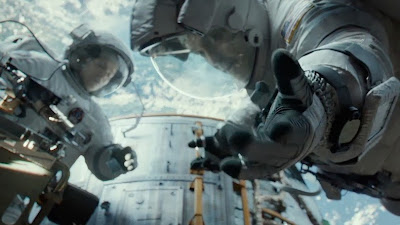Gravity (2013)
Gravity (2013)
Directed by Alfonso Cuarón; Starring Sandra
Bullock, George Clooney
Rating: 4/5
After a month’s absence from
the silver screen, I returned to catch Sandra Bullock spinning off into the abyss
in Alfonso Cuarón’s
intense space thriller Gravity, which
chronicles the struggle of two astronauts to return home when their shuttle is
damaged beyond repair by an unprecedented cascade of destructive space debris.
Though undeniably engaging and
frequently action-packed, there is an understated atmosphere that comes from
the focus on a small cast and their isolation. It’s not pure science-fiction, though
fiction allows it to circumnavigate the criticism it has received for scientific
inaccuracies. In the absence of any vast treatise on the destiny of humanity, Gravity becomes a contemporary space
adventure that is both modern thriller and character drama.
Cuarón is the director of the celebrated Children of Men (2006) and Harry Potter and the Prisoner of Azkaban
(2004), cementing his ability to work within different genres. He also displays
preference for UK based productions: the ostensibly American affair (helmed by
a pair of Hollywood veterans), was in fact shot in Britain.
The term ‘shot’ is used loosely
here, because the real stars are the stunning visual effects, also created in
London. What the production team have created is a live action film that is
almost entirely and inconspicuously computer generated. Our heroes are inserted
into the immersing void above a stunning blue pearl, as they navigate speeding
debris, collapsing spacecraft and vast leagues of emptiness.
Cuarón strays into tried and tested Hollywood
characterisation with his two leads, the newbie and the veteran. Similarly, the
action settles itself in the typical action movie camp, demanding suspension of
disbelief from the audience. It’s easy to lose count of the times someone
miraculously grabs the very last railing before hurtling off to their doom, but
for every time this happens, cinematic karma provides another situation when luck
runs out, and their fate appears sealed.
George Clooney appears as Lt. Matt
Kowalski, an old space dog enjoying his last spacewalk as he pipes country
music through his suit. Clooney’s got the experience: this isn’t his first voyage
to the stars, or the first time his ship’s gone down. However, the story really
belongs to Bullock, who inhabits her character Dr. Ryan Stone (“my dad wanted a boy”) with emotional
intensity.
Stone has none of Kowalski’s
confidence, and is terrified when things go awry. We learn she has lost a young
daughter, and since then retreated into her research. Cuarón revisits
themes of futility explored in Children
of Men as Stone must decide whether to resign herself to fate and be
reunited with her daughter, or fight desperately for life. With little desire
for self preservation, she teeters on the verge of accepting the former more
than once.
The tool of her absolution is
a symbolic rebirth, explicitly visualised when she removes her bulky spacesuit
for the first time and drifts in a foetal position, the cable that tethered her
to the ill-fated shuttle floating past as a suggestive umbilical cord. Dressed simply,
her vulnerability at this point is reminiscent of Sigourney Weaver’s Ripley in Alien (1979).
Gravity is the latest exploration of how far visual technology has
come since the pioneering Avatar
(2009). While that film basked in the visual candy of alien flora and fauna, Gravity’s portrayal of the vacuum of
space, and the perceived lack of a certain fundamental interaction, invites comparisons
with other masterpieces of space on film.
Themes of rebirth and the use
of long, uninterrupted shots owe a debt to 2001:
A Space Odyssey (1968), which is ultimately wider in scope. Though elegance
remains in Kubrick’s classically scored wide shots of docking spacecraft, Gravity ups the ante by dynamically moving
the camera through these long sequences, swooping around characters and
spacecraft to fully exploit the versatile digital environment. Composer Steven
Price’s score meanwhile is haunting silence highlighted by thunderous crescendo.
Long shots are interspersed with the view from Bullock’s perspective,
emphasising disorientation as she spins out of control.
It’s hard to believe 2001 was released 45 years ago when its
effects, created sans computer, still appear so realistic. Kubrick achieved weightlessness
with strings, while cameras filming from unconventional directions turned the pendulum-like
swing into weightless drifting in another axis. The iconic floating pen was
achieved by fixing it to a transparent sheet of rotating plastic. It’s a mark
of how far effects have come that multiple pens, along with a plethora of other
equipment, frequently spin past Bullock as she clambers through space station
interiors.
Apollo 13 (1995) eschewed special effects for the real thing, filming
aboard NASA’s astronaut training aircraft, the famous “Vomit Comet” which
completed hundreds of descents to give the film makers enough time to shoot (with
around 25 seconds of weightlessness a trip). Incidentally, another link between
the films sees (or hears) Apollo 13’s
mission controller Ed Harris reprise his role as the voice of Houston at the
start of Gravity.
Notably absent in Gravity are the Earth-based back stories
and cutaways to Houston’s desperate attempts at rescue – exactly the kind of
narrative that padded out Apollo 13.
Cuarón reportedly
worked hard to exclude this against the wishes of studio executives, preserving
the sense of disconnection and simplicity. When communications go down early in
the film, they are completely on their own.
One exception, which highlights rather than disrupts this, is
Bullock’s connection with Earth as she scans the airwaves, hearing a
non-English-speaking amateur radio enthusiast (revealed in accompanying media
as a Greenlandic fisherman). He does not seem to understand the gravity of the
situation (no pun intended), yet Bullock draws comfort from the sounds of life
on Earth: laughter, a barking dog and most poignantly, the crying of a baby during
what may be her last moments on this mortal coil. But I’m not going to spoil
the ending.



Comments
Post a Comment